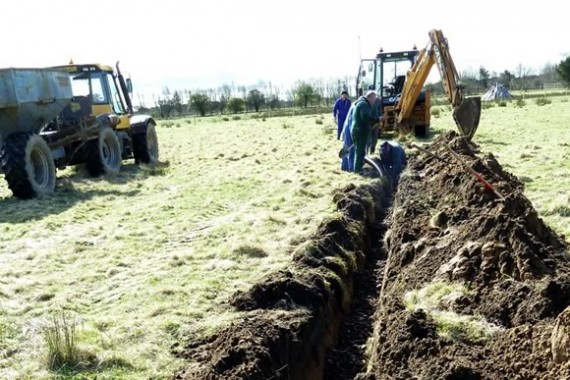Drainage
Many grassland species are relatively tolerant of wet soil. However, grass is not tolerant of physical disturbance, either by hooves or machinery, especially when wet (poaching). If drainage is poor and soil remains wet into spring, mechanical operations and stock turnout may have to be delayed until the soil dries out to reduce the risk of poaching.
Some plant species that would be regarded as weeds also favour wet land – reeds, rushes and buttercups for instance.
Many things – soil type, topography, and soil compaction, can cause poor drainage.
Field drains
The most expensive option is the installation of field drains – plastic pipe run under the soil with a backfill of gravel.
 Installing a field drain
Installing a field drain
Open ditches
Digging ditches and either leaving them open or backfilling with gravel can improve drainage. Open ditches need to be secured from stock, whose hooves will eventually destroy them. Open ditches also need to be regularly cleared.
Mole draining
Mole draining is a mechanical operation whereby a mole plough is drawn along under the soil to break up any soil compaction – like a mole, but bigger. Subsoiling is a similar operation, breaking up the soil up to half a metre down. It must be done in dry conditions.
- Previous « pH and soil nutrients
- Next Sward composition »

About Rosemary Champion
Rosemary lives on a 12 acre smallholding in Angus, in the east of Scotland, where she keeps Ryeland Sheep, Shetland cattle and assorted poultry. She was destined to be a smallholder from an early age.
Further Reading
 Weed Management for Organic Farmers, Growers and Smallholders Gareth Davies |  Improved Grassland Management John Frame |










